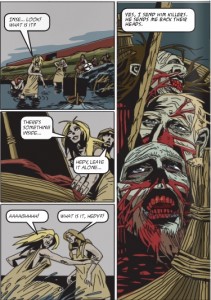Brian Boru – Ireland’s Warrior King
Reviewed by Ian Moore 10-Jul-12
Brian Boru is an enjoyable read, written with a narrative skill that carries the reader forward and brings some sense to the chaotically shifting alliances of the period. You never forget that this is a story set in a brutal time, nor is the backwardness of society ever glossed over for modern readers.
If you grew up in Ireland then Brian Boru is someone you learned about in school. As adults, people remember the schematic outline of his life – that he united Ireland against the Vikings, that he finally broke their power at the battle of Clontarf in 1014, but that he himself was slain on the day of his greatest triumph. This graphic novel attempts to go beyond that sketchy narrative and flesh out the story of Brian’s struggle to dominate Ireland. While it does so it paints a picture of Ireland in the later Dark Ages.
The story is largely told from the point of view of Gormfhlaith, queen of Dublin. Although Irish herself, at a young age she is married to the Norse king of Dublin. Thereafter she works tirelessly to maintain the independence of Dublin as the inheritance of her son Sitric. This inevitably puts her into conflict with the rising power of Brian, for all that she spends some of the book as his wife. Gormfhlaith’s attempts to broker alliances against Brian eventually lead to the mini-armageddon of Clontarf, at which almost all the book’s remaining main characters are killed.
Brian Boru is an enjoyable read, written with a narrative skill that carries the reader forward and brings some sense to the chaotically shifting alliances of the period. You never forget that this is a story set in a brutal time, nor is the backwardness of society ever glossed over for modern readers. Gormfhlaith spends a lot of the book talking about how great Dublin is, but it does seem like little more than a collection of mud huts; even that, though, makes it a shining metropolis compared to Brian’s own base in the west of Ireland.
The book also paints Brian as less of the saintly hero he is in the version Irish people learn from school. He is portrayed as someone who is happy to use brutal force to advance his goals. At one point he kills all the men and boys of a town he has captured – a 10th century Srebrenica. The art reflects the savagery of the times. Somewhat reminiscent of Mike McMahon’s work on Slaine in 2000 AD, its grottiness brings a low-rent quality to the narrative that makes clear that we are in the real mediaeval period and not some airbrushed fantasy world. 
Still, the book does have some strange and somewhat problematic qualities revolving around how it handles time. Gormfhlaith’s son Sitric seems to change overnight from being a child to a young man. Gormfhlaith herself seems to be more or less the same age as Brian at the start of the book. But then at Clontarf, Brian has become a very old man, while she seems to be only slightly older. Of course, the ravages of time may affect people differently.
Time-related quibbles aside, Brian Boru is an impressive piece of work that deserves a wider audience. Although it deals with an Irish subject, it should appeal to anyone who likes reading about political intrigue and people laying into each other with swords and axes. No familiarity with the historical background would be needed to enjoy this – if you had never heard of Brian Boru, you would probably enjoy this even more as a tale of savage violence and cruel reversals of fate.
Tags: Damien Goodfellow, O'Brien Press